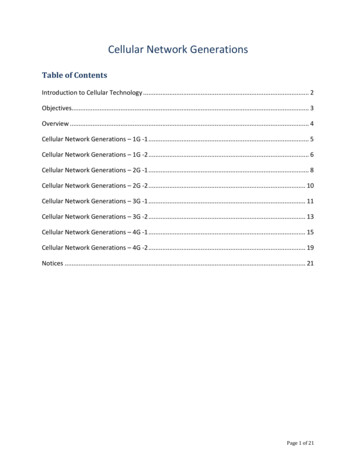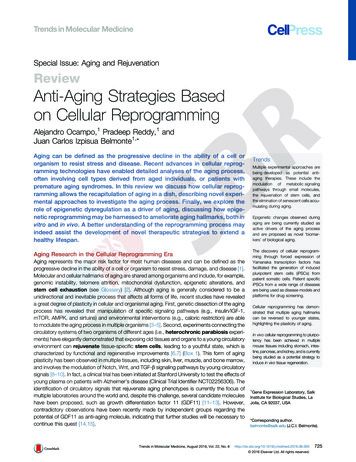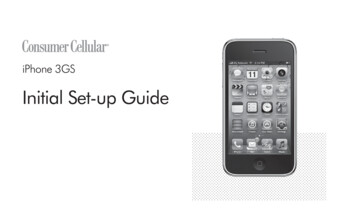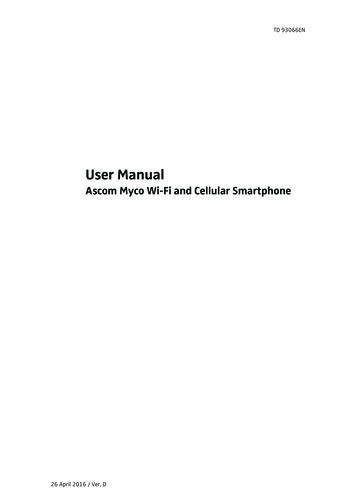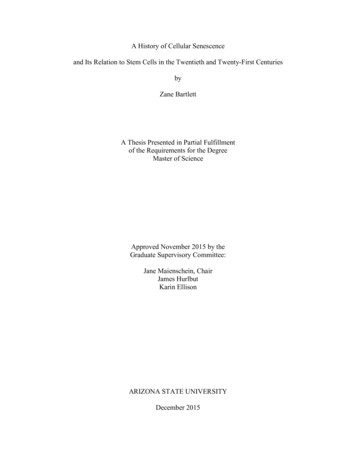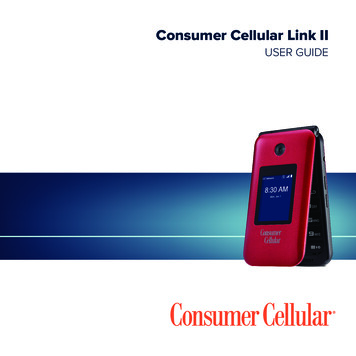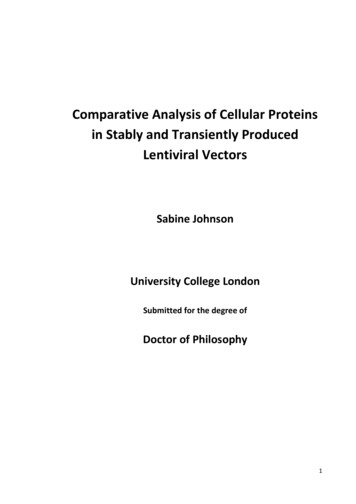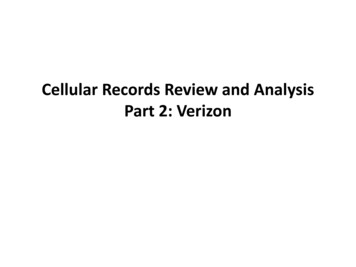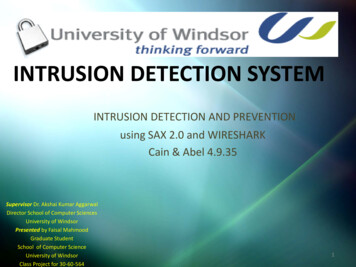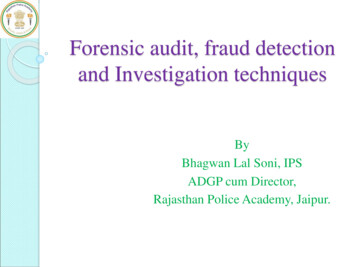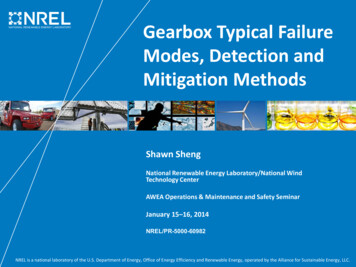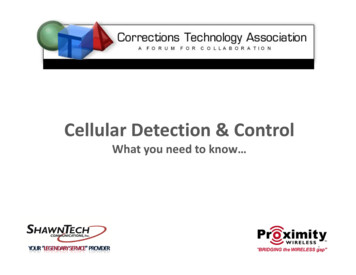
Transcription
Cellular Detection & ControlWhat yyou need to know 1
IntroductionsCorrections Industry: Dr.Dr Reggie Wilkinson – Former Commissioner of OH DOC John Taylor ‐ Former CTO of VA DOCShawnTechShT hCCommunications:i ti David Gittelson – Director of New Business Development Dan DeCerbo – Director of ITProximity Wireless: Keith Ebel ‐ President2
I SSummary off theI.th RResearchh – methods and investmentsII. Terminology – understanding the terms in the headlinesIII. Legislative & Government – proposed laws, laws, and petitionsIV. Current Technology – descriptions and pros/consV. Cellular Carriers – what they are doingVI. The Future – the road ahead3
I. Summary of the Research Two (2) years of studying the cellular problem in prisons‐‐‐‐‐Correctional leaders outlined the problems & required a solutionReviewed six (6) jamming companiesReviewed four (4) detection companiesReviewed three (3) managed access companiesHeld numerous meetings with the cellular carriers and equipmentproviders. Significant R&D investments‐‐‐Conducted RF propagation study/site surveyLegal (written testimony and petitions)FCC – Temporary License (STA) Partnerships‐‐‐Proximity Wireless ‐ in building coverage expertVarious equipment manufacturersCellular carriers4
II. Terminology5
II. TerminologyDetection – Detection is the process of locating, tracking, and identifyingvarious sources of radio transmissions. Detection, or direction finding, is used ina wide variety of applications including, for example, cell phone assignments,th locationthel ti off 911 emergency callsll andd marinei distressdi tcalls.llJamming – Radio jamming is the deliberate radiation, re‐radiation, or reflectionof electromagneticgenergygy for the purposep pof disruptingp g use of electronicdevices, equipment, or systemsManaged Access – intercept calls in order to allow corrections officials toprevent inmates from accessing carrier networks.networks The cell signal is not blockedby a jamming signal, but rather, is captured (or rerouted) and prevented fromreaching the intended base station, thereby disallowing the completion of thecall. Includes an Authorized Allowed, Un‐Authorized and Gray list.Source: National Telecommunications and Information Administration (NTIA) Notice of Inquiry,Preventing Contraband Cell Phone Use in Prisons6
III. Legislative & GovernmentFederal Safe Prisons Communications Act of 2009 – seeks to amend TheCommunications Act of 1934 to allow Jamming for correctional facilities. ShawnTech Written Testimony to include “other technology” ACA / ASCA modified by laws to include “other technology” Approved by Senate S.251 ‐ http://www.govtrack.us/congress/bill.xpd?bill s111‐251 Pending House Vote HR.560 ‐ http://www.govtrack.us/congress/bill.xpd?bill h111‐560 The Cell Phone Contraband Act of 2010 – seeks to amend the federal criminalcode to prohibit the possession or use of cell phones and similar wireless devicesby a Federal Prisoner. Passed Senate April – Referred to the House Committee on the Judiciaryhtt //http://www.govtrack.us/congress/bill.xpd?bill s111‐1749t k //bill d?bill 111 17497
III. Legislative & GovernmentStates California SB 434 ‐ Correctional facilities: wireless communication devicesdevices. –Proposes that anyone in possession of, or delivering (including attempteddelivery) any cellular telephone or other wireless communication device to aperson in the custody of a correctional institution, is guilty of a /sb 0401‐0450/sb 434 bill 20090226 introduced.html Texas HB 3228 – Makes it a felony for a person in the custody of a correctionalfacility to possess a cell .aspx?LegSess 81R&Bill HB3228#8
III. Legislative & GovernmentFCC Petitions District of Columbia – requested to conduct jamming tests CTIA – not in favor of jamming tests South Carolina DOC – requested jamming authorization from the FCC Mississippi DOC – requested that “managed access” systems be allowed bythe FCC National Telecommunication & Information Administration (NTIA) –requested testing of Jamming equipment at a “government agency” – Approved,resultsl pendingdi9
IV. Current Technology10
Pros and Cons of Current CellularInterdiction Techniques andTechnologiesBased on Vendor Interviews, VendorDemonstrations, and Test Implementationsconducted in Maryland
The Problem Inmate cell phone use:‐ Poses security risks at the institutions‐ Permits organized crime and gang leaders to operate their organizationsffromprisoni‐ Poses security risks to the public‐ Reduces revenue and removes audio surveillance of State contractedphone systemspyHow bad is the problem California Corrections :‐‐2006 ‐ 261 cellll phoneshconfiscatedfi t d2008 ‐ 2,811 cell phones confiscated Maryland Corrections:‐‐2008 ‐ 1,2001 200 cellll phoneshconfiscatedfi t d2009 – 1,700 cell phones confiscated12
Systems & Methods in Use and /or Tested Perimeter Security‐ Inmate Re‐entry after Work Release, Outside Details, or Transferg Entryy‐ Staff,, Visitor,, and Package‐ Perimeter Checks Detection Measures‐‐‐‐Cell Phone Sniffing K‐9Handheld Detection DevicesPortable Detection SystemsFixed Detection Systems Cellular Jamming Managed Access13
SecurityPerimeter Security14
Perimeter Security‐ Inmate Re‐Re‐entry after Work Release, Outside Details, or TransferStrip searches and Body Orifice SecurityScanners ((BOSS Chair)) which can detect cellphones and other metallic objects hidden inor on a person.Perimeter SecuritySecurity‐ Staff, Visitor, and Package Entry Metal DetectorsX‐ray MachinesFrisk SearchesDenial of Entryy15
Perimeter Security‐ Perimeter ChecksSecurityCellll phonesChandd cellll bundlesb dlthrown over perimeter fences16
DDetectionDetection17
Detection Measures‐ Cell Phone Sniffing K‐K‐9DDetectionProsConsNon TechnicalDog’s stamina level limits the number ofsearches that can be performed consecutivelyconsecutively.Low cost. Officer’s salary and 4‐5 weekstraining. Can be 4000 a dog, but free forMD due to our breeding program.Dogs only alert to cell phone battery odorDevice does not have to be onLegalg to use todayyTime ConsumingLabor intensiveMaryland DOC:Three dogs working part time arefinding approximately 100 phones ayear.18
Detection MeasuresDDetection‐ Handheld RF Detection DevicesProsConsMobileLow upfront costs ( 5k a device)Detects all technologies available todayShows approx location of devicesLegal to use todayDevice has to be onLimited to no intelligence gathering capabilityPhones are still functionalLabor intensiveLimited upgradesEasy to spot (prevented by shutting the phoneoff)Limited RangeEnvironmental RF interference (false positives)19
Detection Measures‐ Portable RF Detection SystemsConsMobile, can be moved from tier to tierMedium upfront costs ( 50k a system)Power needed to recharge batteriesSystems wireless communications are poor incorrectional facilityNo wiring costsD t t allll technologiesDetectst h l i availableil bl todayt dShows approx location of devicesLegal to use todayHave to secure devices from inmate sabotageD i hasDeviceh tto bbe onLimited to no intelligence gathering capabilityPhones are still functionalLabor intensiveDDetectionPros20
Detection Measures‐ Fixed RF Detection SystemsProsCons 100k for smaller facilitiesD t t allll technologiesDetectst h l i availableil bl todayt dDevice has to be onLi it d iintelligenceLimitedt lligatheringth i capabilitybilitAll cell phone usage is detected andreported all the timeSensors can be PoEPhones are still functionalDDetectionShows approx location of devicesLegal to use todayHave to provide wiring and/or power tosupport detection networkHave to secure devices from inmate sabotageDifficult and costly to adapt to changes in theradiodi e)21
JJammingCellular Jamming22
JJammingCellular JamminggProsConsCan stop all calls on cellular devicesCan stop all technologies availableIllegal (outside of Federal jurisdictions)Indiscriminately jams the frequencyDifficult to prevent jamming outside thefacilities perimeter; especially difficult in metroareas911/e911 and First Responder interferenceCostly for Carriers to supportDifficult and costly to adapt to changes in theradio environmentInterference with the publicDepending on the type of deployment, text andSMS messages may still go through23
Cellular JamminggJJammingThe operation of transmitters designed to jam or block wireless communicationsis a violation of the Communications Act of 1934, as amended ("Act"). See 47U.S.C. Sections 301, 302a, 333. The Act prohibits any person from willfully ormaliciouslyli i l interferingif i withi h theh radiodi communicationsi ioff any stationi lilicensedd orauthorized under the Act or operated by the U.S. government. 47 U.S.C. Section333. The manufacture, importation, sale or offer for sale, including advertising, ofdevices designed to block or jam wireless transmissions is prohibited. 47 U.S.C.Section 302a(b).302a(b) Parties in violation of these provisions may be subject to thepenalties set out in 47 U.S.C. Sections 501‐510. Fines for a first offense can rangeas high as 11,000 for each violation or imprisonment for up to one year, and thedevice used may also be seized and forfeited to the U.S. government.24
Managed AcceessManaged Access25
Managed AccessProsManaged AcceessCan allow and disallow calls, text/SMSmessages, data connections, etc.Allows know "state issued" phones to beusedConsFairly expensive today ( 200k per site)Extensive RF survey and propagation studyneeded to ensure all phones within the facilityperimeter are managedIntelligence gathering capability (number Difficult to keep devices outside the facilitydialed, text messages)perimeter from being managedShows approx location of devicesLimited testing has been conductedCan allow 911/e911 or reroute as needed Limited iDEN, 3G, and 4G availabilityUpgradeableDevice has to be on(software/firmware/hardware)Can exclude prison communicationradios/systemsLegal today with cell phone carrierapproval or FCC STA26
Managed Access Solution27
What are the Keys to Long‐Long‐term Achievable Objectives? All existing and future bands and services must be controlled.Corrections solutions should blend seamlessly with wireless service providernetworks, and not cause any disruptions to service providers or theirnetworks.networksLeverage the technology that is already in place.Benefits of Managed Access Managed Access Works in Rural, Suburban, Urban, and Dense‐Dense‐UrbanEnvironmentsCan use existing cellularll l “macro”“” or adddd DAS to supplementlcoverageand/or support internal services.Scalable and Expandable.Future proof.28
Current Bands & TechnologiesCarrierPublic BandsTechnologyAT&T850MHz, 1900MHz, 2100MHz,700MHz (future)GSM/GPRS, EDGE,UMTS/HSPAUMTS/HSPA, LTE PlannedT‐Mobile1900MHz, 2100MHzGSM/GPRS, EDGE, UMTS, LTEPlannedVerizon850MHz, 1900MHz, 2100MHz,700MHz (future)CDMA, CDMA2000 1xEvDOSprint / NextelClearwire800MHz, 900MHz, 1900MHz,2500MHziDEN, CDMA, CDMA20001xEvDO, WiMAXCricket1900MHz, 2100MHzCDMA, CDMA 1xEvDO29
Technologies Continue to EvolveCellular2G2.5G3GVoiceGSM, IS‐95Voice Data servicesGPRS, EDGEVoice Broadband Data servicesUMTS, cdma20004GWireless LANS802.11b802.11a/Hiperlan IIQoSUp to 11 Mbps2.4 GHz BandUp to 54 Mbps5 GHz BandMulti‐servicesHow does a corrections facility stay ahead of the changeswithout wireless industry leadership and support?30
Cellular Coverage: Impossible to Eliminate via the “MACRO”Propagation Factors Steel Concrete Coated glass Ductwork Partitions Elevators Stairwell Floor to floor Courtyards Dense / OpenDAS (Distributed Antenna System)Carrier Coverage Verizon Alltel AT&T Sprint T‐Mobile Cricket Many facilities will need supplementalcoverage via DAS to support desired services. Corrections will team with niche providers forengineering, survey, design, deployment, andmanagement of such systems.31
Wideband DAS (Distributed Antenna System)Ability to remoteantennasCo-axFiber Cellular Public Safety Land Mobile OtherLower cost perSquare footMore scalableHigh PowerWideband RemoteUnitsU tto 8 SSecondaryUpdhubs per Main hubCoax or FiberUp to 8 AUs persecondary hubOther ServicesDAS infrastructure that services R.F. bands from 136‐2700MHz not only allows control over“Managed Access” wireless services but, is also available to support other desired or requiredcorrectional wireless services. DAS is a natural extension of the cellular macro.32
Part of the Global Wireless InfrastructureGlobalSuburbanUrbanIn toCellUse of contraband cell phones inside prisons is a huge problem, but controlling theproblem does not fall outside existing network infrastructure capabilities.33
Public Safety / First Responders TechnologiesEntityBandsTechnologyPublic SafetyFirst Respondersp150‐174 MHz150‐220‐‐222 MHz220450‐‐470 MHz450470‐‐512 MHz470769‐‐775 MHz769799‐‐805 MHz799806‐‐817 MHz806851‐‐862 MHz851928‐‐930 MHz9281427‐‐1432 MHz14272450‐‐2500 MHz2450Private LMR((Land Mobile Radio))Fixed / Base / MobileCFR47Chapter 1Part 90x960 6.25KHz Digital Channels763‐768 MHz Goes Broadband in 2007763‐793‐‐798 MHz Goes Broadband in 20077936.25KHz,6 25KHz 1212.5KHz,5KHz 25KHzDigital and AnalogMany state, county and local jurisdictions are looking for First Responder coverage solutions intomany types of correctional facilities due to the R.F. dense buildings in which such facilities arehoused. This is true at 450MHz and above and especially important for 700/800/900MHz publicsafety wireless systems. C5 can supply supplemental coverage for these services.34
Controlling the PerimeterPerimeter control is assisted thru use of cellularLocation‐Based Services (LBS). Urban sites will requiremuch better accuracy vs. rural / remote sites. Ruralsites can use an added DAS / uBTS to support bettersignalg & Location Services.U2 U1 C5 uBTS or Outer264m88mProperty469m205mLBS uses time & angle ofarrival, not signal strength.Carrier BaseStations35
U3 ?U1User DeterminationU1 White listed/authorized aredefined by the correctionalauthoritiesU1U3 ?U1U3 ? Black listed/unauthorized areidentified via intelligence gatheringU1 U2U3 ? Gray List users are undeterminedand will be added to white or blacklist pending review/investigation.U2 U1 U1 U2 U1 SymbolU3 ?U1List TagStatusU1 Whit ListWhiteLi tAApproveddU2 Black ListBlockedU3 ?Grey ListTBD36
Urban Facilities & C5 Use ofLBS (L(Locationi BBasedd SServices)i )With proper infrastructure LBS canlocate “gray list” user within 100 footradius.radiusMust actively co‐exist in thecellularll l macro whilehil blockingbl kiunauthorized calls andpassing calls from usersoutside the prison.pEquipment must be able tolocate “gray list” phoneswithin the prison boundaries.37
Keys to Wireless Success Always needs careful RF planning!M st not interfere withMustith NetNetworkorkFlexible InfrastructureMultiple ServicesExpandableScalableCarrier Friendlyy38
V. Cellular Industry39
V. Cellular Industry CTIA‐ Against Jamming‐ Supports “other”other technology Carriers‐ Need to support the “solution” as they own the spectrum‐ Long term sublease agreement needed‐ ROI – sustainable model Vendors / Equipment Manufacturers‐ Managed access limited testing‐ Jamming undergoing Federal testing‐ Detection various Federal and State agencies40
VI. The Future Government‐ NTIA notice of inquiry (NOI)‐ FCC to move issue to public safety (APCO) Manufacturers‐ Prove equipment will meet industry requirements‐ Release 3G, 4G and beyond protocols Correctional Industry‐ Long term testing needed (Leiber CI/STA)‐ Wireless infrastructure/convergence‐ Correctional Cellular Communication Call Control (C5) the nextgeneration of inmate communications41
Contact us for more informationC5@shawntech.com1‐800‐722‐9580CTA Booth #1.42
Questions and Answers?43
Inmate cell phone use: ‐ Poses security risks at the institutions ‐ Permits organized crime and gang leaders to operate their organizations from prison ‐ Poses security risks to the public ‐ Reduces revenue and removes audio surveillance of State contrac
